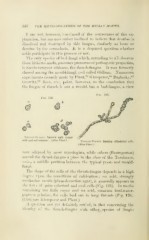Page 374 - My FlipBook
P. 374
346 THE MICRO-ORQANISMS OF THE HUMAN MOUTH. :
I am not, however, convinced of the correctness of this ex-
planation, but am now rather inclined to believe that dentine is
dissolved and destroyed by this fungus, similarly as bone or
dentine by the osteoclasts. It is a disputed question whether
acids participate in this process or not.
The only species of bud-fungi which, according to all observa-
tions hitherto made, possesses pronounced pathogenic properties,
is Saccharomyces albicans, the thrush-fungus. It was formerly
classed among the mould-fungi, and called Oidium. K^umerous
experiments recently made by Plaut,^^ Klemperer,^*" Baginsky,^^
Grawitz,^^ Rees, etc., point, however, to the conclusion that
the fungus of thrush is not a mould, but a bud-iungus, a view
Fio 120.
Fig. 125.
Theush-Fuxgus forming only round
cells and cell-colonies. (After Plant.) '
THRUSH-FrxGCS forming cylindrical cell?.
(After Plant.)
now adopted by most mycologists, while others (Baumgarten)
accord the thrush-fungus a place in the class of the Torulaceae,
— ie.^ a middle position between the typical yeast- and mould-
fungi.
The shape of the cells of the thrush-fungus depends in a high
degree upon the conditions of cultivation; on acid, strongly
saccharine media (plum-decoction agar), it generally appears in
the form of quite spherical and oval cells (Fig. 125). In media
containing but little sugar and no acid, common beef-water-
peptone gelatine, the cells bud out to long threads (Fig. 126j.
(Compare Klemperer and Plant.)
A question not yet definitely settled, is that concerning the
identity of the thrush-fungus with other species of fungi


